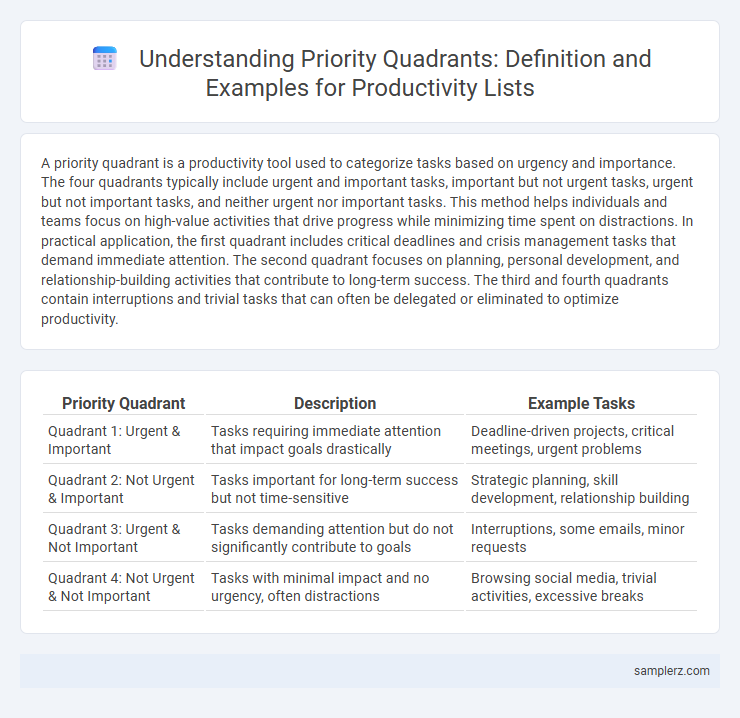A priority quadrant is a productivity tool used to categorize tasks based on urgency and importance. The four quadrants typically include urgent and important tasks, important but not urgent tasks, urgent but not important tasks, and neither urgent nor important tasks. This method helps individuals and teams focus on high-value activities that drive progress while minimizing time spent on distractions. In practical application, the first quadrant includes critical deadlines and crisis management tasks that demand immediate attention. The second quadrant focuses on planning, personal development, and relationship-building activities that contribute to long-term success. The third and fourth quadrants contain interruptions and trivial tasks that can often be delegated or eliminated to optimize productivity.
Table of Comparison
| Priority Quadrant | Description | Example Tasks |
|---|---|---|
| Quadrant 1: Urgent & Important | Tasks requiring immediate attention that impact goals drastically | Deadline-driven projects, critical meetings, urgent problems |
| Quadrant 2: Not Urgent & Important | Tasks important for long-term success but not time-sensitive | Strategic planning, skill development, relationship building |
| Quadrant 3: Urgent & Not Important | Tasks demanding attention but do not significantly contribute to goals | Interruptions, some emails, minor requests |
| Quadrant 4: Not Urgent & Not Important | Tasks with minimal impact and no urgency, often distractions | Browsing social media, trivial activities, excessive breaks |
Understanding the Priority Quadrant Model
The Priority Quadrant Model categorizes tasks into four segments based on urgency and importance: Quadrant 1 includes urgent and important tasks that require immediate attention, such as critical deadlines or crises. Quadrant 2 focuses on important but not urgent activities like strategic planning and relationship building that drive long-term success. Quadrants 3 and 4 contain tasks that are less important, with Quadrant 3 involving urgent but non-essential activities and Quadrant 4 comprising distractions or time-wasters.
The Four Quadrants: An Overview
The Four Quadrants model, developed by Stephen Covey, categorizes tasks into Urgent and Important, Important but Not Urgent, Urgent but Not Important, and Neither Urgent nor Important. Quadrant II, which includes Important but Not Urgent tasks, is critical for long-term productivity and strategic planning. Prioritizing tasks in this quadrant, such as relationship building and personal development, enhances focus and reduces stress caused by last-minute emergencies in Quadrant I.
Quadrant 1: Urgent and Important Examples
Tasks in Quadrant 1 of the productivity priority matrix include crisis management, pressing deadlines, and urgent medical issues, which demand immediate attention. Completing these tasks prevents potential negative consequences and helps maintain workflow stability. Effective handling of urgent and important responsibilities ensures critical objectives are met on time.
Quadrant 2: Not Urgent but Important Tasks
Quadrant 2 tasks, such as strategic planning, skill development, and relationship building, are crucial for long-term productivity and success. These activities prevent crises and reduce urgent interruptions by fostering proactive work habits. Prioritizing Quadrant 2 tasks enhances time management and overall effectiveness.
Quadrant 3: Urgent but Not Important Activities
Quadrant 3 in the priority matrix includes tasks like responding to non-critical emails, attending certain meetings, and handling minor interruptions that demand immediate attention but do not significantly contribute to long-term goals. These activities often create a false sense of urgency, diverting focus from more impactful work. Effective time management involves minimizing time spent in Quadrant 3 to preserve energy for high-priority tasks in Quadrants 1 and 2.
Quadrant 4: Not Urgent and Not Important Items
Quadrant 4 in the priority matrix includes tasks such as scrolling social media, watching TV mindlessly, and engaging in excessive online shopping, which neither contribute to important goals nor require immediate attention. These activities consume valuable time and reduce overall productivity by diverting focus from meaningful work. Minimizing Quadrant 4 tasks helps increase efficiency and create space for tasks that drive progress and personal growth.
Visualizing Your To-Do List with the Quadrant System
Visualizing your to-do list using the Priority Quadrant System enhances productivity by categorizing tasks into four distinct segments: urgent and important, important but not urgent, urgent but not important, and neither urgent nor important. This method clarifies focus by directing attention to tasks that yield the highest impact, such as project deadlines (urgent and important) versus routine emails (urgent but not important). Employing the quadrant system streamlines task management, reduces procrastination, and optimizes time allocation for maximum efficiency.
Practical Examples of Prioritizing Daily Tasks
A practical example of prioritizing daily tasks using the priority quadrant includes categorizing items into urgent and important, such as completing critical project deadlines and addressing client communications first. Tasks that are important but not urgent, like skill development and long-term planning, are scheduled next to ensure sustained progress. Less critical tasks, including routine emails and basic organization, are deferred or delegated to optimize productivity and focus on high-impact activities.
Tips for Assigning Tasks to the Right Quadrant
Assign tasks based on urgency and importance by placing critical deadlines and high-impact projects in Quadrant 1 for immediate action. Schedule tasks with strategic value but lower urgency in Quadrant 2 to enhance long-term productivity. Delegate or defer less important, urgent tasks and eliminate trivial activities found in Quadrants 3 and 4 to optimize time management.
Maximizing Productivity Using Priority Quadrants
Priority quadrants categorize tasks into four segments based on urgency and importance, enabling focused time management. Quadrant 2, which includes important but not urgent tasks, maximizes productivity by emphasizing strategic planning, goal setting, and relationship building. Prioritizing these activities reduces stress and prevents crises, leading to long-term efficiency and success in both personal and professional contexts.

example of priority quadrant in list Infographic
 samplerz.com
samplerz.com